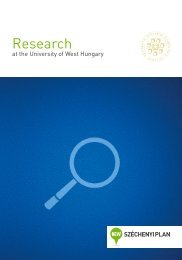Facskó Ferenc (szerk.) (2012): Kutatások a Nyugat-magyarországi
Facskó Ferenc (szerk.) (2012): Kutatások a Nyugat-magyarországi
Facskó Ferenc (szerk.) (2012): Kutatások a Nyugat-magyarországi
Create successful ePaper yourself
Turn your PDF publications into a flip-book with our unique Google optimized e-Paper software.
A regionális fejlődés műszaki innovációs hátterének fejlesztése<br />
L. CSOKA – T. R. APPEL – A. EITNER – G. JIRIKOWSKI – J. MAKOVITZKY (<strong>2012</strong>): Polarization<br />
optical-histochemical characterization and supramolecular structure of carbohydrate<br />
fi brils. ACTA HISTOCHEM -: (-)doi10.1016/j.acthis<br />
Abstract – Topo-optical staining reactions were used to investigate the structures of bacterial<br />
cellulose, insect chitosan and alginic acid from brown algae. Polysaccharide complexes,<br />
glycosaminoglycans and sulfate groups were presented and demonstrated selectively. Chitosan<br />
and alginic acid are structurally similar to glycosaminoglycans (GAGs), which are<br />
constituents of human amyloid fi brils. The staining sequences shown can be used as reliable<br />
methods for histochemistry with light and polarization microscopy. They will help to<br />
clarify the complex protein–polysaccharide structure of amyloid fi brils.<br />
CSOKA L. – HOEGER I. – ROJAS O.J. – PESZLEN I. – PAWLAK J. J. – PERALTA P. N. (<strong>2012</strong>): Piezoelectric<br />
Eff ect of Cellulose Nanocrystals Thin Films. ACS MACRO LETTERS 1: pp.<br />
867-870.<br />
Abstract – Ultrathin fi lms of aligned cellulose nanocrystals (CNCs) were assembled on<br />
mica supports by using electric fi eld-assisted shear. The relationship between polarization<br />
gradients and strain mechanics of the obtained fi lms was examined by monitoring their<br />
defl ection with an atomic force microscope operated in contact mode. The piezoelectric<br />
response of the fi lms was ascribed to the collective contribution of the asymmetric crystalline<br />
structure of the cellulose crystals. The magnitude of the eff ective shear piezoelectric<br />
constant (d25) of highly ordered CNC fi lms was determined to be 2.1 Å/V, which is comparable<br />
to that of a reference fi lm of a piezoelectric metal oxide.<br />
L. CSOKA – D. K. BOZANIC – V. NAGY – S. DIMITRIJEVIC-BRANKOVIC – A. S. LUYT – G. GROZDITS –<br />
V. DJOKOVIC (<strong>2012</strong>): Viscoelastic properties and antimicrobial activity of cellulose fi ber<br />
sheets impregnated with Ag nanoparticles. CARBOHYDRATE POLYMERS 90:(2) pp.<br />
1139-1146.<br />
Abstract – A silver nanoparticle colloid was prepared by a modifi ed Tollens method using dglucose<br />
as the reduction agent. The obtained nanoparticles were used for the modifi cation<br />
of pine, linter and recycled cellulose fi bers. Although the silver contents were relatively low<br />
(0.05–0.13 wt.%), the cellulose-sheets prepared from the modifi ed fi bers show improved<br />
mechanical and viscoelastic properties. The tensile index (strength) increased with up to<br />
30% in comparison to the index of the sheets obtained from the untreated fi bers. The infl uence<br />
of the nanoparticles on the viscoelastic properties of the cellulose sheets was investigated<br />
by dynamic mechanical analysis (DMA) in the temperature range from -120 to 20 °C<br />
and with a force frequency of 100 Hz. A broad relaxation transition positioned at -80 °C was<br />
observed in the loss modulus spectrum of all the cellulose sheets, while the Ag-modifi ed<br />
sheets exhibited higher storage moduli values in the whole temperature range. The antimicrobial<br />
activity tests show that the pine, silver and recycled cellulose fi ber sheets with silver<br />
nanoparticles can be successfully employed to prevent the viability and growth of the common<br />
pathogens Staphylococcus aureus, Escherichia coli and Candida albicans.<br />
A projekt során létrejött eredmények mind alapkutatási szinten, mind pedig alkalmazott<br />
anyagtudomány szinten jelentősek és előre mutatóak, a kapcsolódó iparág fejlesztési<br />
irányainak alapjait tartalmazhatják. Célunk, hogy az eredményeket ipari szinten, termékek<br />
formájában mielőbb alkalmazhassuk. A további kutatásokat pályázati forrásokból, az<br />
iparági szereplőkkel közösen, a fejlesztési érdekeiknek megfelelően szeretnénk folytatni.<br />
255



